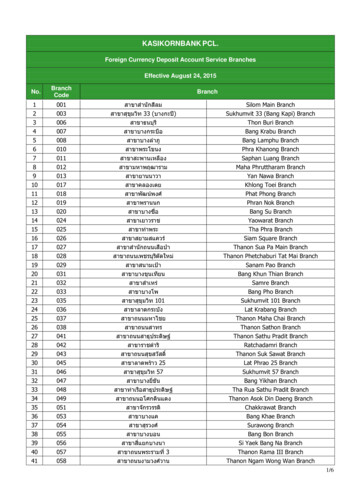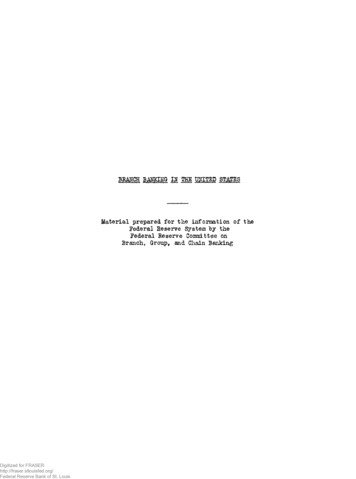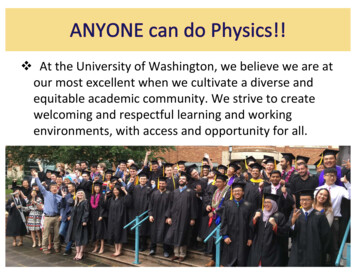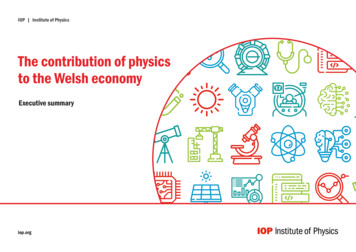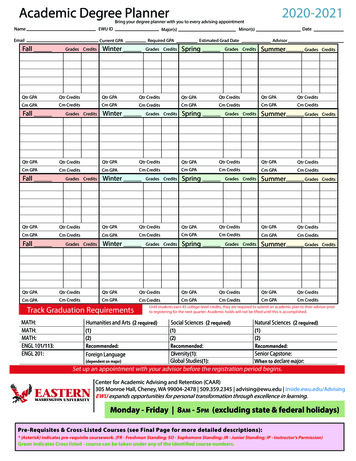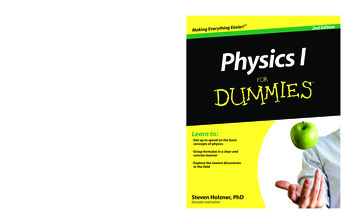
Transcription
AP Physics 1Newton's Law of Universal Gravitation2017-07-19www.njctl.org
Newton's Law of Universal GravitationClick on the topic to go to that section· Gravitational Force· Gravitational Field· Surface Gravity· Gravitational Field in Space· Orbital Motion· Kepler's Third Law of Motion
Gravitational ForceReturn toTable ofContents
Newton’s Law of Universal GravitationIt has been wellknown since ancienttimes that Earth is asphere and objectsthat are near thesurface tend falldown.
Newton’s Law of Universal GravitationNewton connected the ideathat objects, like apples, falltowards the center of Earthwith the idea that the moonorbits around Earth.it'salso falling towards thecenter of Earth.The moon just stays incircular motion since it hasa velocity perpendicular toits acceleration.click here for a cool episode of "minute physics" aboutwhy Earth orbits the sun and doesn't crash into it!
Newton’s Law of Universal GravitationNewton concluded that all objects attract one another with a"gravitational force". The magnitude of the gravitational forcedecreases as the centers of the masses increases in distance.MORE Gravitational attractionM1M2rM1LESS Gravitational attractionrM2
Newton’s Law of Universal GravitationMathematically, the magnitude of the gravitational forceis proportional to the masses of the objects and inverselyproportional to the square of the distance between the two objects.
Gravitational ConstantG 6.67 x 10-11 N-m2 /kg2In 1798, Henry Cavendishmeasured G using a torsion beambalance. He did not initially set outto measure G, he was instead tryingto measure the density of the Earth.Click here for an interesting video by "SixtySymbols" about the unusual man HenryCavandish and his contributions to science.
Newton’s Law of Universal GravitationThe direction of the force is along the line connecting thecenters of the two masses. Each mass feels a force ofattraction towards the other mass.along that line.r
Newton’s Law of Universal GravitationNewton's third law tells us that the force on each mass isequal.That means that if I drop a pen, the force of Earth pulling thepen down is equal to the force of the pen pulling Earth up.However, since the mass of Earth is so much larger, thatforce causes the pen to accelerate down, while themovement of Earth up is completely unmeasurable.
1 What is the magnitude of the gravitational forceABCDE2.0 x 10 18 N2.0 x 1019 N2.0 x 1020 N2.0 x 1021 NI need helpAnswerbetween Earth and its moon?r 3.8 x 108mmEarth 6.0 x 1024kgmmoon 7.3 x 1022 kg
2 What is the magnitude of the gravitational forceABCDE3.6 x 10-18 N3.6 x 1019 N3.6 x 1021 N3.6 x 1022 NI need helpAnswerbetween Earth and its sun?r 1.5 x 1011 mmEarth 6.0 x 1024kgmsun 2.0 x 1030 kg
3 The gravitational force between two objects is F.A1/2 FB1/4 FC2FD4FEI need helpAnswerWhat is the force F' between those objects when thedistance between them is halved?
4 The gravitational force between two objects is F.A1/4 FB1/2 FC2FD4FEI need helpAnswerWhat is the force F' between those objects when themass of one object is doubled?
5 The gravitational force between two objects is F.A1/4 FB1/2 FC 2FD 4FEI need helpAnswerWhat is the force F' between those objects when thedistance between them is doubled?
Newton’s Law of Universal GravitationRecall that density is:Where m is mass and V is volume.And that the volume of a sphere is:Where r is the radius of the sphere.Now we can see what happens to the gravitational forcebetween two objects when the mass, density, or volume ischanged.
Newton’s Law of Universal GravitationFor example, lets look at thegravitational force between twospheres shown to the right.SinceFG can be written as:R1R2
6 Two solid spheres made of the same material andA1/2 FB2FC 8FD 16 FEI need helpAnswerradii R attract each other with a gravitational force F,when they are in contact with each other. The twospheres are replaced with two new spheres of thesame material with radii 2R. What is the newgravitational force between them in terms of F?
7 Two solid spheres made of the same material andA3/4 FB9/4 FC 27/4 FD 4/3 FEI need helpAnswerradii R attract each other with a gravitational force F,when they are in contact with each other. One of thespheres is replaced with a new sphere of the samematerial with radii 3R. What is the new gravitationalforce between them in terms of F?
Gravitational FieldReturn toTable ofContents
Gravitational FieldWhile the force between two objects can always be computedby using the formula for F ; it's sometimes convenient toconsider one mass as creating a gravitational field and theother mass responding to that field.G
Gravitational FieldThe magnitude of the gravitational field created by an object variesfrom location to location in space; it depends on the distance fromthe object and the object's mass.Gravitational field, g, is a vector. It'sdirection is always towards the objectcreating the field.That's the direction of the force that atest mass would experience if placedat that location. In fact, g is theacceleration that a mass wouldexperience if placed at that location inspace.
8 Where is the gravitational field the strongest?EBAnswerDACF I need help
9 What happens to the gravitational field if theABCDEIt doublesIt quadruplesIt is cut to one halfIt is cut to one fourthI need helpAnswerdistance from the center of an object doubles?
10 What happens to the gravitational field if theABCDEIt doublesIt quadruplesIt is cut to one halfIt is cut to one fourthI need helpAnswermass of an object doubles?
Surface GravityReturn toTable ofContents
Surface GravityPlanets, stars, moons, all have a gravitational field.since they allhave mass.That field is largest at the object's surface, where the distance fromthe center of the object is the smallest.when "r" is the radius of theobject.By the way, only the mass ofthe planet that's closer to thecenter of the planet than youare contributes to itsgravitational field. So thefield actually gets smaller ifyou tunnel down below thesurface.RM
11 Determine the surface gravity of Earth's moon. Itsmass is 7.4 x 1022 kg and its radius is 1.7 x 106 m.A 1.7 m/s2C 4.4 m/s2D 6.2 m/s2E I need helpAnswerB 2.9 m/s2
12 Compute g for the surface of a planet whose radius isdouble that of the Earth and whose mass is triple thatof Earth.B 3.36 m/s2C 5.91 m/s2D 7.32 m/s2E I need helpAnswerA 1.89 m/s2
Surface GravityAgain density is:So.And that the volume of a sphere is:Now we can see what happens to the surface gravity of aplanet when the mass, density, or volume is changed.
Surface GravityFor example, we can rewrite the equation for surface gravityin terms of density and radius.
13 Compute g for the surface of a planet whose radius isABCDE1/4 gearth1/2 gearth2 gearth4 gearthI need helpAnswerdouble that of the Earth and whose density is the sameas that of Earth.
14 Compute g for the surface of a planet whose radius isABCDE1/9 gearth1/3 gearth3 gearth9 gearthI need helpAnswerthe same as that of the Earth and whose density is 1/3that of Earth.
15 Compute g for the surface of a planet whose radius isABCDE1.7 N/kg2.5 N/kg7.4 N/kg13 N/kgI need helpAnswerhalf that of Earth and whose density is 3/2 that ofEarth.
Gravitational Fieldin SpaceReturn toTable ofContents
Gravitational field in spaceWhile gravity gets weakeras you get farther from aplanet, it never becomeszero.There is always somegravitational field presentdue to every planet, starand moon in the universe.
Gravitational field in spaceThe local gravitational fieldis usually dominated bynearby masses sincegravity gets weaker as theinverse square of thedistance.The contribution of a planetto the local gravitationalfield can be calculatedusing the same equationwe've been using. You justhave to be careful about "r".
Gravitational field in spaceThe contribution of a planet to the local gravitational field can becalculated using the same equation we've been using. You justhave to be careful about "r".If a location, "A", is a height "h" above a planet of radius "R", it is adistance "r" from the planet's center, where r R h.RMrhA
16 Determine the gravitational field of Earth at a heightof 6.4 x 106 m (1 Earth radius). Earth's mass is 6.0 x1024 kg and its radius is 6.4 x 106 m.A 1.7 m/s2C 4.2 m/s2D 6.9 m/s2E I need helpAnswerB 2.5 m/s2
17 Determine the gravitational field of Earth at aheight 2.88 x 108 m above its surface (the heightof the moon above Earth).Earth's mass is 6.0 x 1024 kg and its radius is6.4 x 106 m.B 1.4x10-4 m/s2C 8.2x10-3 m/s2D 4.6x10-3 m/s2E I need helpAnswerA 6.1x10-4 m/s2
The International Space Station (ISS)The International Space Station (ISS) is a research facility that is in aLow Earth Orbit and can be seen from Earth with the naked eye! Itson-orbit construction began in 1998.It orbits at an altitude of approximately350 km (190 mi) above the surface ofthe Earth, and travels at an averagespeed of 27,700 kilometers (17,210mi) per hour. This means theastronauts see 15 sunrises everyday!
18 The occupants of the space station appear to beweightless, they float. Determine the strength ofEarth's gravitational field acting on astronaut's in theinternational space station.Earth's mass is 6.0 x 1024 kg and its radius is 6.4 x106 m. The ISS is 350km (3.5 x 105m) above thesurface of the earth.B 3.9 m/s2C 5.7 m/s2D 8.8 m/s2E I need helpAnswerA 1.3 m/s2
19 How does the gravitational field acting on theA It's the same.B It's slightly less.C It's about half as strong.D There is no gravity acting on them.E I need helpAnsweroccupants in the space station compare to thatacting on you now.
Orbital MotionReturn toTable ofContents
Orbital MotionWe've already determined that thegravitational field acting on theoccupants of the space station,and on the space station itself, isnot very different than the fieldacting on us here on Earth's surface.RhrEarthISSHow come they don't fall to Earth?This diagram should look really familiar .
Orbital MotionThe gravitational field will be pointedtowards the center of Earth andrepresents the acceleration that amass would experience at thatlocation (regardless of the mass).EarthaISSIn this case any object wouldsimply fall to Earth.How could that be avoided?
Orbital MotionIf the object has a tangentialvelocity perpendicular to itsacceleration, it will go in acircle.vIt will keep falling to Earth, butnever strike Earth.aClick here for an interesting look at why the astronautsinside the space station appear to be weightless.
Orbital MotionHere is Newton's own drawing of athought experiment where a cannonon a very high mountain (above theatmosphere) shoots a shell withincreasing speed, shown bytrajectories for the shell of D, E, F,and G and finally so fast that it neverfalls to earth, but goes into orbit.click here for another look at trajectories and orbitalmotion by Kahn Academy
Orbital MotionWe can calculate the velocitynecessary to maintain a stableorbit at a distance "r" from thecenter of a planet of mass "M".va
Orbital MotionFrom that, we can calculate theperiod, T, of any object's orbit.orva
20 Compute g at a distance of 7.3 x 108 m from the centerof a spherical object whose mass is 3.0 x 1027 kg.A 0.38 m/s2C 0.71 m/s2D 0.88 m/s2E I need helpAnswerB 0.55 m/s2
21 Use your previous answer to determine the velocity,both magnitude and direction, for an object orbitingat a distance of 7.3 x 108 m from the center of aspherical object whose mass is 3.0 x 1027 kg.B 8.8x103 m/sC 1.6x104 m/sD 5.5x104 m/sE I need helpAnswerA 3.1x103 m/s
22 Use your previous answer to determine the orbital period offor an object orbiting at a distance of 7.3 x 108 m from thecenter of a spherical object whose mass is 3.0 x 1027 kg.A 2.9x105 sC 3.8x106 sD 7.9x106 sE I need helpAnswerB 6.5x105 s
23 Compute g at a height of 59 earth radii above theA 8.8x10-3 m/s2B 2.7x10-3 m/s2C 7.2x10-2 m/s2D 3.1x10-2 m/s2E I need helpAnswersurface of Earth.
24 Use your previous answer to determine the velocity,both magnitude and direction, for an object orbiting atheight of 59 RE above the surface of Earth.B 1500 m/sC 1700 m/sD 2000 m/sE I need helpAnswerA 1000 m/s
25 Use your previous answer to determine the orbitalperiod of an object orbiting at height of 59 RE abovethe surface of Earth.B 2.4x106 sC 4.9x106 sD 7.3x106 sE I need helpAnswerA 1.2x106 s
26 Two satellites orbit two different planets with theABCDEv2 (2)v1v2 2v1v2 4v1v2 v1/2I need helpAnswersame radius but different densities. The density ofthe first planet is ρ and the density of the secondplanet is 2ρ. Both satellites are at the same heightabove their planets. What is the orbital speed of thesecond satellite in terms if the orbital speed of thefirst?
27 Two satellites orbit two different planets at the sameABCDEv2 (2)v1v2 2v1v2 v1v2 2 (2)v1I need helpAnswerdistance to the center of the planet and with thesame density but different radii. The radius of thefirst planet is R and the radius of the second planetis 2R. What is the orbital speed of the secondsatellite in terms if the orbital speed of the first?
Kepler's ThirdLaw of MotionReturn toTable ofContents
Orbital MotionNow, we can find the relationship betweenthe period, T, and the orbital radius, r, forany orbit.va
Kepler's Third LawKepler had noted that the ratio of T / r yields the same resultfor all the planets. That is, the square of the period of anyplanet's orbit divided by the cube of its distance from the sunalways yields the same number.23We have now shown why: (4π ) / (GM) is a constant; its thesame for all orbiting objects, where M is the mass of the objectbeing orbited; it is independent of the object that is orbiting.2
Kepler's Third LawIf you know the period (T) of aplanet's orbit, you candetermine its distance (r) fromthe sun.Since all planets orbiting thesun have the same period todistance ratio, the following istrue:T(white)T(green) r(green)r(white)2233
28 The period of the Moon is 27.3 days and its orbitalradius is 3.8 x 108 m. What would be the orbital radiusof an object orbiting Earth with a period of 20 days?B 2.2x108 mC 3.1x108 mD 4.0x108 mE I need helpAnswerA 1.0x108 m
29 What is the orbital period (in days) of an unknownobject orbiting the sun with an orbital radius of twicethat of earth?B 690 daysC 854 daysD 1032 daysE I need helpAnswerA 470 days
AP Physics 1 Newton's Law of Universal Gravitation 2017-07-19 www.njctl.org. Newton's Law of Universal Gravitation Click on the topic to go to that section · Gravitational Force · Gravitational Field · Orbital Motion · Kepler's Third Law of Motion · Surface Gravity · Gravitational Field in Space. Return to

